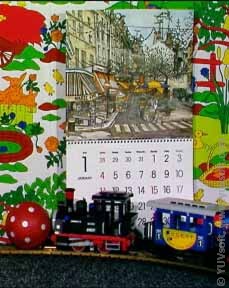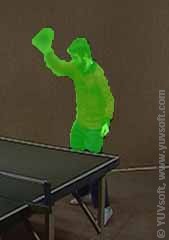YUV Segmentation
Short Description
Download:
- Booklet, PDF (806 KB)
- Video for managers (short), WMV (6.01 MB)
- Video for developers (with technical details), WMV (6.30 MB)
| With the recent intensive growth of the Internet and World Wide Web, interest in advanced interactivity with multimedia data is increasing rapidly. This interest has stimulated the development of new standards for implementing sophisticated multimedia functionality. One such standard is MPEG-4, which introduced content-based representation of video data. Scenes are treated as compositions of several visual objects, which are separately encoded and decoded. This approach allows for easy enabling of various content-based functionalities in multimedia applications.
Our solution uses sophisticated foreground-background (FG-BG) discrimination algorithms in order to automatically detect and trace foreground objects. Foreground object detection is performed using combined analysis of color and motion information from the video stream. One significant advantage of our algorithm is the possibility of foreground object detection even in cases of very slow motion, an ability not typically found in other methods of FG-BG classification. Another principal advantage of our solution is the range of speed-quality trade-offs, which allows adaptation to a given application. This adaptation is achieved by performing the segmentation at various levels, from single-pixel to 16×16 block precision. |
Examples of Work
The first example is from the “Mobile Calendar” standard test video sequence. This example demonstrates the performance of YUV Segmentation for very slow motion:
 |
 |
| Original frame | YUV Segmentation result |
The second example is from the “Table Tennis” standard test video sequence. This example demonstrates the performance of the algorithm for fast motion (please focus your attention at the hand of the player):
 |
 |
| Original frame | YUV Segmentation result |
The third example shows the results for the “Bus” standard test video sequence. This example demonstrates the performance of the algorithm in cases of complex motion (the bus is moving behind the static fence):
 |
| Original frame |
 |
| YUV Segmentation result |
Primary Applications
- Content-based representation of multimedia data
- Sophisticated query and retrieval of video
- Systems for content-based access and manipulation of multimedia data
- Production of object-based information to be used in multimedia data standards
- Improvement of coding efficiency in video codecs
- Content-based interactivity and content-based scalability of multimedia data
- Other content-based functionalities for multimedia applications
Key Features
- Several segmentation precision levels
- No manual segmentation required
- Numerous control parameters for fine tuning
- Adjustable speed/quality trade-off
Basic Deliverables
- Source code for a reference implementation in C
- C and assembly language source code for an implementation optimized for the PC (if required)
- Algorithm description
- Software description
- Verification instructions
Contact Information
For information on licensing, please contact our sales staff.

 Follow
Follow